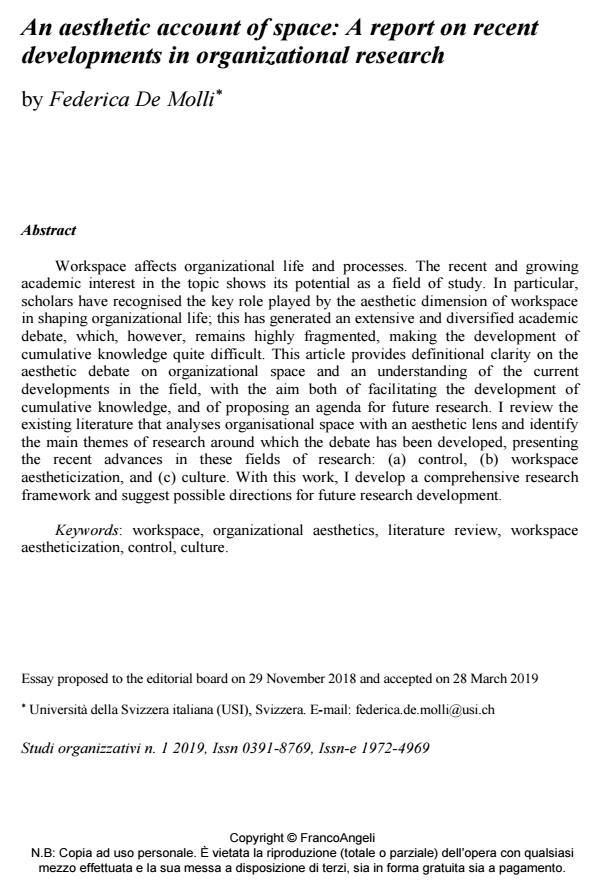An aesthetic account of space: A report on recent developments in organizational research
Titolo Rivista STUDI ORGANIZZATIVI
Autori/Curatori Federica De Molli
Anno di pubblicazione 2019 Fascicolo 2019/1
Lingua Inglese Numero pagine 26 P. 38-63 Dimensione file 585 KB
DOI 10.3280/SO2019-001002
Il DOI è il codice a barre della proprietà intellettuale: per saperne di più
clicca qui
Qui sotto puoi vedere in anteprima la prima pagina di questo articolo.
Se questo articolo ti interessa, lo puoi acquistare (e scaricare in formato pdf) seguendo le facili indicazioni per acquistare il download credit. Acquista Download Credits per scaricare questo Articolo in formato PDF

FrancoAngeli è membro della Publishers International Linking Association, Inc (PILA)associazione indipendente e non profit per facilitare (attraverso i servizi tecnologici implementati da CrossRef.org) l’accesso degli studiosi ai contenuti digitali nelle pubblicazioni professionali e scientifiche
Workspace affects organizational life and processes. The recent and growing academic interest in the topic shows its potential as a field of study. In particular, scholars have recognised the key role played by the aesthetic dimension of workspace in shaping organizational life; this has generated an extensive and diversified academic debate, which, however, remains highly fragmented, making the development of cumulative knowledge quite difficult. This article provides definitional clarity on the aesthetic debate on organizational space and an understanding of the current developments in the field, with the aim both of facilitating the development of cumulative knowledge, and of proposing an agenda for future research. I review the existing literature that analyses organisational space with an aesthetic lens and identify the main themes of research around which the debate has been developed, presenting the recent advances in these fields of research: (a) control, (b) workspace aestheticization, and (c) culture. With this work, I develop a comprehensive research framework and suggest possible directions for future research development.
L’articolo ha l’obiettivo di illustrare le caratteristiche della ricerca estetica sullo spazio organizzativo e i suoi sviluppi recenti, al fine di fornire agli studiosi un quadro completo sul dibattito in corso, dal quale partire per future ricerche e sviluppi. Negli ultimi decenni infatti, si è assistito ad un crescente interesse nello studio dello spazio organizzativo, visto come fattore in grado di influenzare l’agire organizzativo. Studi recenti inoltre, hanno sottolineato come non solo la dimensione fisica, ma anche quella estetica dello spazio abbia una grande influenza sulla vita organizzativa. Questa nuova consapevolezza ha generato un intenso e diversificato dibattito, che tuttavia rimane ad oggi molto frammentato, rendendo quindi difficile lo sviluppo di una conoscenza cumulativa. Questo articolo, dopo aver illustrato le particolarità della ricerca estetica sullo spazio organizzativo, esamina la letteratura empirica sull’argomento. Dalla revisione della letteratura, emerge che lo studio della dimensione estetica dello spazio organizzativo si è sviluppato principalmente attorno a tre tematiche: (a) controllo organizzativo, (b) esteticizzazione del luogo di lavoro e (c) cultura organizzativa. Viene quindi sintetizzato il dibattito in questi tre ambiti di ricerca e vengono ipotizzati possibili futuri sviluppi. Il quadro completo che emerge da questo lavoro vuole essere un utile strumento che gli studiosi interessati alla dimensione estetico-spaziale delle organizzazioni potranno usare sia per orientarsi nel dibattito, che come punto di partenza per future riflessioni e ricerche.
Parole chiave:Spazio organizzativo, estetica organizzativa, revisione della letteratura, esteticizzazione dello spazio, controllo, cultura.
- Sensing gourmetization and gastronomy as organizing practices Marcelo de Souza Bispo, Aline Lacerda Lino da Silva, in Culture and Organization /2022 pp.379
DOI: 10.1080/14759551.2021.2019737 - How to Work with Space Karen Messer, pp.15 (ISBN:978-3-031-46540-6)
- Space Matters: Exploring the Role of Organisational Space in Repairing Organisational Trust Federica De Molli, Lakshmi Balachandran Nair, Marilena Vecco, Émilie Lapointe, in Journal of Management Inquiry 10564926251396792/2025
DOI: 10.1177/10564926251396792 - How to Work with Space Karen Messer, pp.103 (ISBN:978-3-031-46540-6)
- How to Work with Space Karen Messer, pp.1 (ISBN:978-3-031-46540-6)
- Reintroducing technology to the coworking debate: prospects and problematics Maddalena Sorrentino, Lia Tirabeni, Maria Laura Toraldo, in STUDI ORGANIZZATIVI 2/2023 pp.70
DOI: 10.3280/SO2022-002003 - Participatory interpretation: a way to overcome analytical challenges in organizational aesthetic research Federica De Molli, in Culture and Organization /2021 pp.226
DOI: 10.1080/14759551.2020.1806839 - Arts-Based Management between Actions and Conjunctions: Lessons from a Systematic Bibliometric Analysis Larbi Safaa, Anas Khazi, Dalia Perkumienė, Vytautas Labanauskas, in Administrative Sciences /2023 pp.200
DOI: 10.3390/admsci13090200
Federica De Molli, An aesthetic account of space: A report on recent developments in organizational research in "STUDI ORGANIZZATIVI " 1/2019, pp 38-63, DOI: 10.3280/SO2019-001002